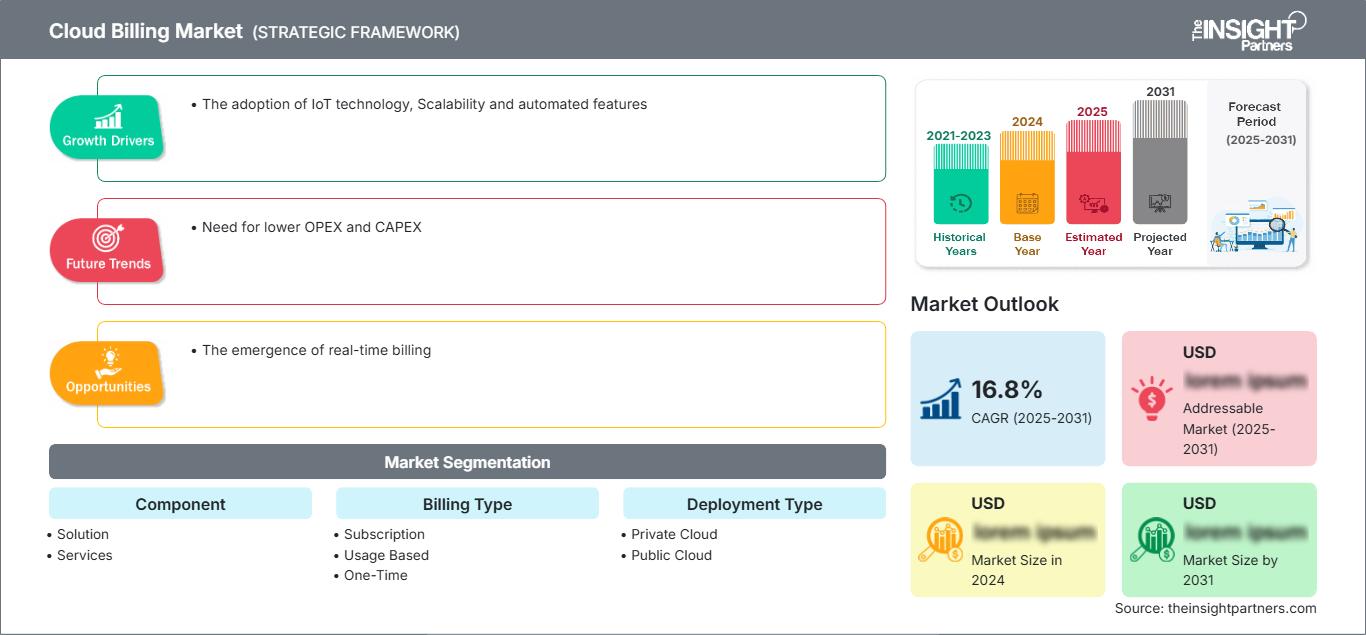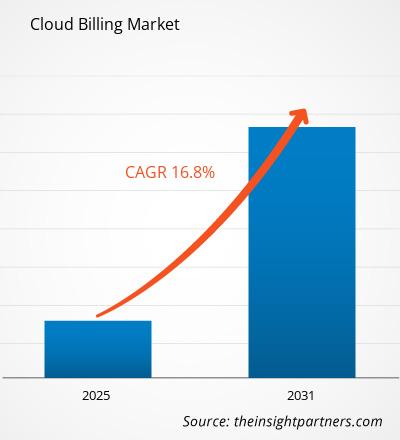页面已更新 :
Sep 2024
预计 2023 年至 2031 年期间,云计费市场的复合年增长率将达到 16.8%。实时计费的兴起很可能仍将是市场的主要趋势。
云计费市场分析
- 从历史上看,计费系统属于劳动密集型系统,并且使用静态的本地软件。相比之下,云计费系统位于 Web 服务器上,提供实时数据处理和计费信息。
- 这种配置适用于提供多种消费模式服务的公司,因为它可以正确跟踪和计费所使用的服务。
- 借助云计费,实时洞察计费数据可以帮助企业做出战略决策,发现模式和改进机会。
云计费市场概览
- 云计费是一种基于云环境中的资源消耗数据生成账单的方法。这种计费方法可以实现计费流程的自动化管理、可扩展和定制化。
- 它对于软件、基础设施和在线平台等服务尤其有益。
- 对于组织而言,这是一种动态、适应性强且高效的计费需求管理方法,尤其是在不同客户之间的服务和消费差异很大的环境中。
自定义此报告以满足您的要求
您将免费获得任何报告的定制,包括本报告的部分内容,或国家级分析、Excel 数据包,以及为初创企业和大学提供超值优惠和折扣
云计费市场: 战略洞察

- 获取本报告的主要市场趋势。这个免费样本将包括数据分析,从市场趋势到估计和预测。
自定义此报告以满足您的要求
您将免费获得任何报告的定制,包括本报告的部分内容,或国家级分析、Excel 数据包,以及为初创企业和大学提供超值优惠和折扣
云计费市场: 战略洞察

- 获取本报告的主要市场趋势。这个免费样本将包括数据分析,从市场趋势到估计和预测。
云计费市场驱动因素和机遇
可扩展性和自动化功能。
- 可扩展性是云计费的一个重要方面。随着公司的发展或需求的变化,云计费系统可以进行相应的调整,使公司能够准确地计费,而无需频繁升级或调整系统。
- 此外,云计费通常包含一些高级功能,例如自动开票、集成支付处理和全面的财务报告。这些功能简化了计费流程,同时还提供了有关收入流和客户使用习惯的有用见解。
需要降低 OPEX 和 CAPEX
- 云计费系统提供可定制的计费周期、定价结构和付款选择,以满足不同消费者群体的需求。
- 云计费系统使您能够自动执行发票、付款处理和收入确认等常见操作,从而减少错误和管理开销。
- 这些解决方案通常基于订阅,使公司可以避免在硬件和软件方面进行大量的前期投资。这也有助于降低与 IT 维护和升级相关的成本。
云计费市场报告细分分析
有助于得出云计费市场分析的关键细分是组件、计费类型、部署类型、服务模型、企业规模和行业垂直。
- 按组件,市场分为解决方案和服务。
- 根据计费类型,市场分为订阅、基于使用、一次性和其他。
- 根据部署类型,市场分为私有云和公共云。
- 根据服务模型,市场分为 IaaS、PaaS 和 SaaS。
- 按企业规模,市场分为大型企业和中小型企业。
- 按行业垂直,市场分为 BFSI、IT 和电信、教育、医疗保健、媒体和
- 云计费市场报告对五个主要地理区域进行了详细分析,包括当前和历史市场规模以及 2021 年至 2031 年的预测,涵盖北美、欧洲、亚太地区 (APAC)、中东和非洲 (MEA) 以及南美洲和中美洲。
- 每个区域进一步细分为相应的国家/地区。本报告提供 18 个国家/地区的分析和预测,涵盖云计费市场动态,例如影响区域市场的驱动因素、趋势和机会。
- 此外,该报告还涵盖 PEST 分析,其中涉及研究影响这些地区云计费市场的主要因素。
云计费市场区域洞察
Insight Partners 的分析师已详尽阐述了预测期内影响云计费市场的区域趋势和因素。本节还讨论了北美、欧洲、亚太地区、中东和非洲以及南美和中美洲的云计费市场细分和地域分布。
云计费市场报告范围
| 报告属性 | 细节 |
|---|---|
| 市场规模 2024 | US$ XX million |
| 市场规模 2031 | US$ XX Million |
| 全球复合年增长率 (2025 - 2031) | 16.8% |
| 历史数据 | 2021-2023 |
| 预测期 | 2025-2031 |
| 涵盖的领域 |
By 组件
|
| 覆盖地区和国家 | 北美
|
| 市场领导者和主要公司简介 |
|
云计费市场参与者密度:了解其对业务动态的影响
云计费市场正在快速增长,这得益于终端用户需求的不断增长,而这些需求又源于消费者偏好的不断变化、技术进步以及对产品优势的认知度不断提升等因素。随着需求的增长,企业正在扩展其产品线,不断创新以满足消费者需求,并抓住新兴趋势,从而进一步推动市场增长。

- 获取 云计费市场 主要参与者概述
云计费市场新闻及最新发展
云计费市场评估通过收集一手和二手资料后的定性和定量数据进行,这些数据包括重要的企业出版物、协会数据和数据库。云计费市场的一些发展如下:
- FinOps 基金会发布了 FinOps 开放成本和使用规范 (FOCUS) 1.0 版,该规范承诺简化同类云服务成本的比较。FOCUS 在 2024 年 FinOps X 大会上发布,为亚马逊网络服务 (AWS)、微软、谷歌和甲骨文支持的云账单提供了统一的格式。 (来源:FinOps Foundation,新闻稿,2024 年 6 月)
云计费市场报告覆盖范围和可交付成果
《云计费市场规模和预测(2021-2031)》报告对市场进行了详细的分析,涵盖以下领域:
- 涵盖范围内所有关键细分市场的全球、区域和国家/地区云计费市场规模和预测
- 云计费市场趋势以及市场动态,例如驱动因素、限制因素和关键机遇
- 详细的 PEST/波特五力模型和 SWOT 分析
- 云计费市场分析涵盖关键市场趋势、全球和区域框架、主要参与者、法规和最新市场发展
- 行业格局和竞争分析涵盖市场集中度、热图分析、知名参与者和云计费市场的最新发展
- 详细的公司简介
- 历史分析(2 年)、基准年、预测(7 年)及复合年增长率
- PEST和SWOT分析
- 市场规模、价值/数量 - 全球、区域、国家
- 行业和竞争格局
- Excel 数据集
近期报告
客户评价
购买理由
- 明智的决策
- 了解市场动态
- 竞争分析
- 客户洞察
- 市场预测
- 风险规避
- 战略规划
- 投资论证
- 识别新兴市场
- 优化营销策略
- 提升运营效率
- 顺应监管趋势
我们的客户































87-673-9708

ISO 9001:2015



 获取免费样品 - 云计费市场
获取免费样品 - 云计费市场